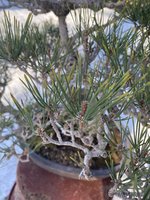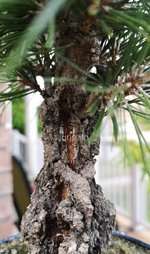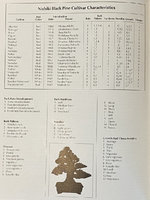Corkbark JBP can have flaky bark like yours; which can eventually display a “tortoise shell” bark, or even ridges. Other cultivars develop those “wings” they’re famous for. If you didn't get the cultivar name, likely the provenance is lost. However, if I was guessing, my guess would be ‘Akame’. They’re
relatively common, have red (
aka) buds, thin needles and flaky bark. This cultivar will eventually show some ridges, but the bark is still flaky and not persistent. Hachi-gen Is another variety that could fit the bill, but they’re not common.
Where did it come from? What information do you have about the tree’s origin? That could help too.
Here are a few different descriptions of the cultivar, see if they describe yours.
From Evergreen Gardenworks:
View attachment 344847
From Steve Pilacik’s book, “Japanese Black Pines”:
View attachment 344848
From International Bonsai Magazine, Winter 1980:
View attachment 344849








